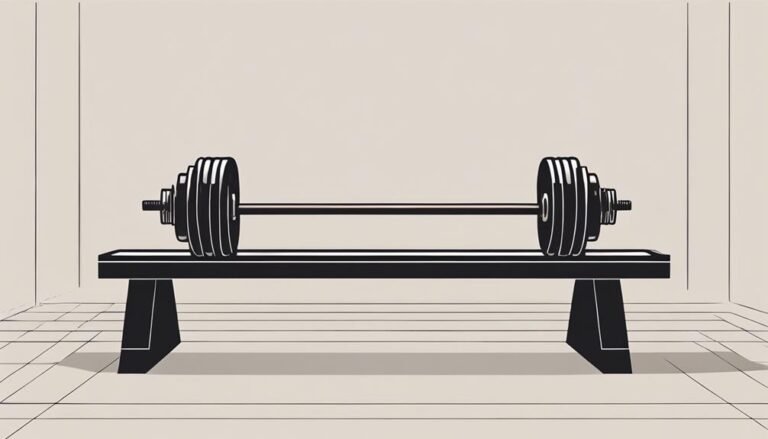5 Best Joint-Friendly Strength Exercises for Men 40
If you're over 40 and want to strengthen your body without stressing your joints, focus on these five joint-friendly exercises. Start with bodyweight squats to target your lower body, then move to the dumbbell chest press for upper body strength. Incorporate resistance band rows to enhance your back muscles while keeping joint stress low. Next, try seated leg presses for strong legs with minimal impact on knees and hips. Finally, add some planks for core stability. These exercises not only boost strength but also promote better joint health. Stick around to uncover even more effective techniques tailored for your wellness.
Key Takeaways
- Bodyweight squats enhance lower body strength, targeting quadriceps, hamstrings, and glutes without excessive joint stress.
- Dumbbell chest presses build upper body strength while promoting joint health through controlled movements.
- Resistance band rows strengthen the upper back, minimizing strain on joints and enhancing stability.
- Seated leg presses improve lower body strength with reduced impact on knees and hips, ideal for joint health.
Importance of Joint-Friendly Exercises
Joint-friendly exercises are essential for maintaining mobility and strength as you age, helping you stay active without putting unnecessary stress on your joints.
These exercises reduce the risk of injuries, allowing you to continue your favorite activities with confidence.
By focusing on low-impact movements, you can enhance your overall fitness without exacerbating existing joint issues.
You'll find that joint-friendly workouts not only improve your strength but also boost your flexibility and balance, which are vital for daily tasks.
Incorporating these exercises into your routine can lead to better joint health, helping you maintain a higher quality of life.
Exercise 1: Bodyweight Squats

Bodyweight squats are a fantastic way to build strength in your lower body while being gentle on your joints. They engage your quadriceps, hamstrings, and glutes, enhancing stability and balance. Plus, you can do them anywhere without any equipment.
Here's a quick overview of the benefits, tips, and variations for bodyweight squats:
| Aspect | Details | Tips |
|---|---|---|
| Benefits | Strengthens lower body | Keep your back straight |
| Technique | Feet shoulder-width apart | Lower down to your comfort |
| Variations | Jump squats, sumo squats | Adjust depth based on ability |
| Frequency | 2-3 times a week | Aim for 3 sets of 10-15 reps |
| Progression | Add weights or increase reps | Listen to your body |
With practice, you'll notice improved strength and mobility.
Exercise 2: Dumbbell Chest Press
After strengthening your lower body with bodyweight squats, it's time to work on your upper body with the dumbbell chest press, a great exercise for building strength while being easy on your joints.
To perform the dumbbell chest press, lie on a flat bench with a dumbbell in each hand, arms extended above your chest. Lower the weights slowly until your elbows are at about a 90-degree angle. This controlled motion minimizes strain on your shoulders and wrists.
Press the dumbbells back to the starting position, engaging your chest muscles. Aim for 3 sets of 8-12 repetitions, adjusting the weight as needed.
This exercise not only enhances upper body strength but also promotes stability and joint health. Enjoy the gains!
Exercise 3: Resistance Band Rows

Incorporating resistance band rows into your routine is an effective way to strengthen your back while minimizing joint stress. This exercise targets your upper back, improving posture and overall strength without the heavy impact of traditional weights.
Here's how to get started:
- Setup: Anchor the band at a low point and grab the handles with both hands, standing back to create tension.
- Execution: Pull the handles towards your torso while squeezing your shoulder blades together, keeping your elbows close to your body.
- Repetition: Aim for 10-15 reps for 2-3 sets, adjusting the band's resistance to maintain proper form.
With consistency, resistance band rows can enhance your strength and stability, keeping your joints happy in the process.
Exercise 4: Seated Leg Press
The seated leg press is a fantastic way to build lower body strength while reducing strain on your knees and hips. This exercise targets your quadriceps, hamstrings, and glutes without putting too much pressure on your joints.
To perform the seated leg press, sit in the machine with your back against the pad and feet placed shoulder-width apart on the platform. Push the platform away by extending your legs, but don't lock your knees. Slowly return to the starting position and repeat for the desired number of reps.
Adjust the weight according to your fitness level, and aim for three sets of 10-15 reps. Incorporating the seated leg press into your routine can help improve strength and stability, making daily activities easier.
Questions
How Often Should I Perform These Exercises Weekly?
You should aim to perform these exercises about two to three times a week. This frequency helps build strength while allowing your body to recover, ensuring you stay safe and effective in your workouts.
Are There Any Specific Warm-Up Routines Recommended?
It's funny how a good warm-up can make all the difference. You should try dynamic stretches like leg swings or arm circles, and don't forget to include light cardio to get your heart pumping before workouts.
Can I Do These Exercises at Home?
Absolutely, you can do these exercises at home! Just make certain you have enough space, some basic equipment, and focus on proper form. This way, you'll maximize effectiveness while minimizing the risk of injury.
What Equipment Do I Need for These Exercises?
Research shows that 70% of home exercisers use minimal equipment. For these exercises, you'll need dumbbells, resistance bands, and an exercise mat. Optional items include a stability ball and a pull-up bar for added variety.
How Can I Track My Progress Safely?
To track your progress safely, keep a workout journal, noting weights, reps, and sets. Use a fitness app for easy updates. Regularly reassess your goals and adjust your routine based on your results.
Conclusion
Incorporating joint-friendly strength exercises into your routine isn't just about avoiding pain; it's about empowering your body for a healthier future.
You might think these exercises won't challenge you enough, but they actually build strength and stability without straining your joints.
By focusing on quality movements, you'll enhance your overall fitness and keep your body moving freely as you age.
Embrace these exercises, and you'll be investing in your long-term health and energy.







